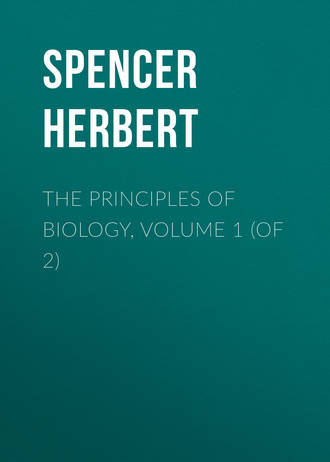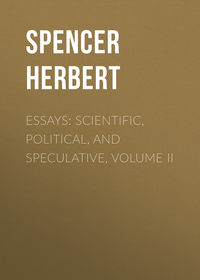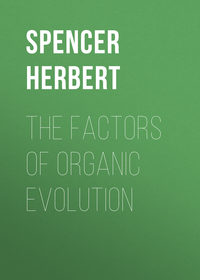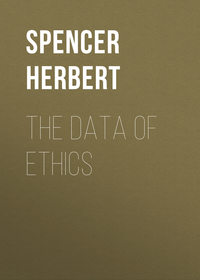 полная версия
полная версияThe Principles of Biology, Volume 1 (of 2)
A corollary of great significance may here be drawn. It has been observed that within a vegetal cell the strands of protoplasm stretched in this or that direction contain moving granules, showing that the strands carry currents. It has also been observed that when the fission of a protozoon is so nearly complete that its two halves remain connected only by a thread, currents of protoplasm move through this thread, now one way now the other. The inference fairly to be drawn is that such currents pass also through the strands which unite the protoplasts forming a tissue. What must happen? So long as adjacent cells with their contents are subject to equal pressures no tendency to redistribution of the protoplasm exists, and there may then occur the action sometimes observed inside the strands within a cell: currents with their contained granules moving in opposite directions. But if the cells forming a portion of tissue are subject to greater pressure than the cells around, their contained protoplasm must be forced through the connecting threads into these surrounding cells. Every change of pressure at every point must cause movements and counter-movements of this kind. Now in the Metazoa at large, or at least in all exhibiting relative motions of parts, and especially in all which are capable of rapid locomotion, such changes of pressure are everywhere and always taking place. The contraction of a muscle, besides compressing its components, compresses neighbouring tissues; and every instant contractions and relaxations of muscles go on throughout the limbs and body during active exertion. Moreover, each attitude – standing, sitting, lying down, turning over – entails a different set of pressures, both of the parts on one another and on the ground; and those partial arrests of motion which result from sitting down the feet alternately when running, send jolts or waves of varying pressure through the body. The vital actions, too, have kindred effects. An inspiration alters the stress on the tissues throughout a considerable part of the trunk, and a heart-beat propels, down to the smallest arteries, waves which slightly strain the tissues at large. The component cells, thus subject to mechanical disturbances, small and great, perpetual and occasional, are ever having protoplasm forced into them and forced out of them. There are gurgitations and regurgitations which, if they do not constitute a circulation properly so called, at least imply an unceasing redistribution. And the implication is that in the course of days, weeks, months, years, each portion of protoplasm visits every part of the body.
Without here stating specifically the bearings of these inferences upon the problems of heredity, it will be manifest that certain difficulties they present are in a considerable degree diminished.
§ 54e. Returning from this parenthetical discussion to the subject of structure, we have to observe that besides facts presented by tissues and facts presented by organs, there are certain facts, less general than the one and more general than the other, which must now be noted. In the order of decreasing generality an account of organs should be preceded by an account of systems of organs. Some of these, as the muscular system and the osseous system, are co-extensive with tissues, but others of them are not. The nervous system, for example, contains more than one kind of tissue and is constituted of many different structures: besides afferent and efferent nerves there are the ganglia immediately controlling the viscera, and there are the spinal and cerebral masses, the last of which is divisible into numerous unlike parts. Then we have the vascular system made up of the heart, arteries, veins, and capillaries. The lymphatic system, too, with its scattered glands and ramifying channels has to be named. And then, not forgetting the respiratory system with its ancillary appliances, we have the highly heterogeneous alimentary system; including a great number of variously-constructed organs which work together. On contemplating these systems we see their common character to be that while as wholes they cooperate for the carrying on of the total life, each of them consists of cooperative parts: there is cooperation within cooperation.
There is another general aspect under which structures must be contemplated. They are divisible into the universal and the particular – those which are everywhere present and those which occupy special places. The blood which a scratch brings out shows us that the vascular system sends branches into each spot. The sensation accompanying a scratch proves that the nervous system, too, has there some of its ultimate fibrils. Unobtrusive, and yet to be found at every point, are the ducts of the lymphatic system. And in all parts exists the connective tissue – an inert tough substance which, running through interspaces, wraps up and binds together the other tissues. As is implied by this description, these structures stand in contrast with local structures. Here is a bone, there is a muscle, in this place a gland, in that a sense-organ. Each has a limited extent and a particular duty. But through every one of them ramify branches of these universal structures. Every one of them has its arteries and veins and capillaries, its nerves, its lymphatics, its connective tissue.
Recognition of this truth introduces what little has here to be said concerning organs; for of course in a work limited to principles no detailed account of these can be entered upon. This remainder truth is that, different as they may be in the rest of their structures, all organs are alike in certain of their structures. All are furnished with these appliances for nutrition, depuration and excitation: they have all to be sustained, all to be stimulated, all to be kept clean. It has finally to be remarked that the general structures which pervade all the special structures at the same time pervade one another. The universal nervous system has everywhere ramifying through it the universal vascular system which feeds it; and the universal vascular system is followed throughout all its ramifications by special nerves which control it. The lymphatics forming a drainage-system run throughout the other systems; and in each of these universal systems is present the connective tissue holding their parts in position.
§ 54f. So vast and varied a subject as organic structure, even though the treatment of it is limited to the enunciation of principles, cannot, of course, be dealt with in the space here assigned. Next to nothing has been said about plant-structures, and in setting forth the leading traits of animal-structures the illustrations given have been mostly taken from highly-developed creatures. In large measure adumbration rather than exposition is the descriptive word to be applied.
Nevertheless the reader may carry away certain truths which, exemplified in a few cases, are exemplified more or less fully in all cases. There is the fundamental fact that the plants and animals with which we are familiar —Metaphyta and Metazoa– are formed by the aggregation of units homologous with Protozoa. These units, often conspicuously showing their homology in early embryonic stages, continue some of them to show it throughout the lives of the highest type of Metazoa, which contain billions of units carrying on a protozoon life. Of the protoplasts not thus active the great mass, comparatively little transformed in low organisms, become more and more transformed as the ascent to high organisms goes on; so that, undergoing numerous kinds of metamorphoses, they lose all likeness to their free homologues, both in shape and composition. The cell-contained protoplasts thus variously changed are fused together into tissues in which their individualities are practically lost; but they nevertheless remain connected throughout by permeable strands of protoplasm. Arising by complication of the outer and inner layers of the embryo and growing more unlike as their units become more obscured, these tissues are formed into systems, which develop into sets of organs. Some of the resulting structures are localized and special but others are everywhere interfused.
While the first named of these facts are displayed in every Metazoon, and while the last named are visible only in Metazoa of considerably developed structures, a gradual transition is shown in intermediate kinds of Metazoa. Of this transition it remains to say that it is effected by the progressive development of auxiliary appliances. For example, the primitive foot-cavity is a sac with one opening only; then comes a second opening through which the waste-matter of the food is expelled. The alimentary canal between these openings is at first practically uniform; afterwards in a certain part of its wall arise numerous bile-cells; these accumulating form a hollow prominence; and this, enlarging, becomes in higher types a liver, while the hollow becomes its duct. In other gradual ways are formed other appended glands. Meanwhile the canal itself has its parts differentiated: one being limited to swallowing, another to triturating, another to adding various solvents, another to absorbing the prepared nutriment, another to ejecting the residue. Take again the visual organ. The earliest form of it is a mere pigment-speck below the surface. From this (saying nothing here of multiple eyes) we rise by successive complications to a retina formed of multitudinous sensory elements, lenses for throwing images upon it, a curtain for shutting out more or less light, muscles for moving the apparatus about, others for adjusting its focus; and, finally, added to these, either a nictitating membrane or eyelids for perpetually wiping its surface, and a set of eyelashes giving notice when a foreign body is dangerously near. This process of elaborating organs so as to meet additional requirements by additional parts, is the process pursued throughout the body at large.
Of plant-structures, concerning which so little has been said, it may here be remarked that their relative simplicity is due to the simplicity of their relations to food. The food of plants is universally distributed, while that of animals is dispersed. The immediate consequences are that in the one case motion and locomotion are superfluous, while in the other case they are necessary: the differences in the degrees of structure being consequences. Recognizing the locomotive powers of minute Algæ and the motions of such other Algæ as Oscillatoria, as well as those movements of leaves and fructifying organs seen in some Phænogams, we may say, generally, that plants are motionless; but that they can nevertheless carry on their lives because they are bathed by the required nutriment in the air and in the soil. Contrariwise, the nutriment animals require is distributed through space in portions: in some cases near one another and in other cases wide apart. Hence motion and locomotion are necessitated; and the implication is that animals must have organs which render them possible. In the first place there must be either limbs or such structures as those which in fish, snakes, and worms move the body along. In the second place, since action implies waste, there must be a set of channels to bring repairing materials to the moving parts. In the third place there must be an alimentary system for taking in and preparing these materials. In the fourth place there must be organs for separating and excreting waste-products. All these appliances must be more highly developed in proportion as the required activity is greater. Then there must be an apparatus for directing the motions and locomotions – a nervous system; and as fast as these become rapid and complex the nervous system must be largely developed, ending in great nervous centres – seats of intelligence by which the activities at large are regulated. Lastly, underlying all the structural contrasts between plants and animals thus originating, there is the chemical contrast; since the necessity for that highly nitrogenous matter of which animals are formed, is entailed by the necessity for rapidly evolving the energy producing motion. So that, strange as it seems, those chemical, physical, and mental characters of animals which so profoundly distinguish them from plants, are all remote results of the circumstance that their food is dispersed instead of being everywhere present.
CHAPTER III.
FUNCTION
§ 55. Does Structure originate Function, or does Function originate Structure? is a question about which there has been disagreement. Using the word Function in its widest signification, as the totality of all vital actions, the question amounts to this – does Life produce Organization, or does Organization produce Life?
To answer this question is not easy, since we habitually find the two so associated that neither seems possible without the other; and they appear uniformly to increase and decrease together. If it be said that the arrangement of organic substances in particular forms, cannot be the ultimate cause of vital changes, which must depend on the properties of such substances; it may be replied that, in the absence of structural arrangements, the forces evolved cannot be so directed and combined as to secure that correspondence between inner and outer actions which constitutes Life. Again, to the allegation that the vital activity of every germ whence an organism arises, is obviously antecedent to the development of its structures, there is the answer that such germ is not absolutely structureless.
But in truth this question is not determinable by any evidence now accessible to us. The very simplest forms of life known (even the non-nucleated, if there are any) consist of granulated protoplasm; and granulation implies structure. Moreover since each kind of protozoon, even the lowest, has its specific mode of development and specific activity – even down to bacteria, some kinds of which, otherwise indistinguishable, are distinguishable by their different reactions on their media – we are obliged to conclude that there must be constitutional differences between the protoplasms they consist of, and this implies structural differences. It seems that structure and function must have advanced pari passu: some difference of function, primarily determined by some difference of relation to the environment, initiating a slight difference of structure, and this again leading to a more pronounced difference of function; and so on through continuous actions and reactions.
§ 56. Function falls into divisions of several kinds according to our point of view. Let us take these divisions in the order of their simplicity.
Under Function in its widest sense, are included both the statical and the dynamical distributions of force which an organism opposes to the forces brought to bear on it. In a tree the woody core of trunk and branches, and in an animal the skeleton, internal or external, may be regarded as passively resisting the gravity and momentum which tend habitually or occasionally to derange the requisite relations between the organism and its environment; and since they resist these forces simply by their cohesion, their functions may be classed as statical. Conversely, the leaves and sap-vessels in a tree, and those organs which in an animal similarly carry on nutrition and circulation, as well as those which generate and direct muscular motion, must be considered as dynamical in their actions. From another point of view Function is divisible into the accumulation of energy (latent in food); the expenditure of energy (latent in the tissues and certain matters absorbed by them); and the transfer of energy (latent in the prepared nutriment or blood) from the parts which accumulate to the parts which expend. In plants we see little beyond the first of these: expenditure being comparatively slight, and transfer required mainly to facilitate accumulation. In animals the function of accumulation comprehends those processes by which the materials containing latent energy are taken in, digested, and separated from other materials; the function of transfer comprehends those processes by which these materials, and such others as are needful to liberate the energies they contain, are conveyed throughout the organism; and the function of expenditure comprehends those processes by which the energy is liberated from these materials and transformed into properly co-ordinated motions. Each of these three most general divisions includes several more special divisions. The accumulation of energy may be separated into alimentation and aeration; of which the first is again separable into the various acts gone through between prehension of food and the transformation of part of it into blood. By the transfer of energy is to be understood what we call circulation; if the meaning of circulation be extended to embrace the duties of both the vascular system and the lymphatics. Under the head of expenditure of energy come nervous actions and muscular actions: though not absolutely co-extensive with expenditure these are almost so. Lastly, there are the subsidiary functions which do not properly fall within any of these general functions, but subserve them by removing the obstacles to their performance: those, namely, of excretion and exhalation, whereby waste products are got rid of. Again, disregarding their purposes and considering them analytically, the general physiologist may consider functions in their widest sense as the correlatives of tissues – the actions of epidermic tissue, cartilaginous tissue, elastic tissue, connective tissue, osseous tissue, muscular tissue, nervous tissue, glandular tissue. Once more, physiology in its concrete interpretations recognizes special functions as the ends of special organs – regards the teeth as having the office of mastication; the heart as an apparatus to propel blood; this gland as fitted to produce one requisite secretion and that to produce another; each muscle as the agent of a particular motion; each nerve as the vehicle of a special sensation or a special motor impulse.
It is clear that dealing with Biology only in its larger aspects, specialities of function do not concern us; except in so far as they serve to illustrate, or to qualify, its generalities.
§ 57. The first induction to be here set down is a familiar and obvious one; the induction, namely, that complexity of function is the correlative of complexity of structure. The leading aspects of this truth must be briefly noted.
Where there are no distinctions of structure there are no distinctions of function. A Rhizopod will serve as an illustration. From the outside of this creature, which has not even a limiting membrane, there are protruded numerous processes. Originating from any point of the surface, each of these may contract again and disappear, or it may touch some fragment of nutriment which it draws with it, when contracting, into the general mass – thus serving as hand and mouth; or it may come in contact with its fellow-processes at a distance from the body and become confluent with them; or it may attach itself to an adjacent fixed object, and help by its contraction to draw the body into a new position. In brief, this speck of animated jelly is at once all stomach, all skin, all mouth, all limb, and doubtless, too, all lung. In organisms having a fixed distribution of parts there is a concomitant fixed distribution of actions. Among plants we see that when, instead of a uniform tissue like that of many Algæ, everywhere devoted to the same process of assimilation, there arise, as in the higher plants, root and stem and leaves, there arise correspondingly unlike processes. Still more conspicuously among animals do there result varieties of function when the originally homogeneous mass is replaced by heterogeneous organs; since, both singly and by their combinations, modified parts generate modified changes. Up to the highest organic types this dependence continues manifest; and it may be traced not only under this most general form, but also under the more special form that in animals having one set of functions developed to more than usual heterogeneity there is a correspondingly heterogeneous apparatus devoted to them. Thus among birds, which have more varied locomotive powers than mammals, the limbs are more widely differentiated; while the higher mammals, which rise to more numerous and more involved adjustments of inner to outer relations than birds, have more complex nervous systems.
§ 58. It is a generalization almost equally obvious with the last, that functions, like structures, arise by progressive differentiations. Just as an organ is first an indefinite rudiment, having nothing but some most general characteristic in common with the form it is ultimately to take; so a function begins as a kind of action that is like the kind of action it will eventually become, only in a very vague way. And in functional development, as in structural development, the leading trait thus early manifested is followed successively by traits of less and less importance. This holds equally throughout the ascending grades of organisms and throughout the stages of each organism. Let us look at cases: confining our attention to animals, in which functional development is better displayed than in plants.
The first differentiation established separates the two fundamentally-opposed functions above named – the accumulation of energy and the expenditure of energy. Passing over the Protozoa (among which, however, such tribes as present fixed distributions of parts show us substantially the same thing), and commencing with the lowest Cœlenterata, where definite tissues make their appearance, we observe that the only large functional distinction is between the endoderm, which absorbs nutriment, and the ectoderm which, by its own contractions and those of the tentacles it bears, produces motion: the contractility being however to some extent shared by the endoderm. That the functions of accumulation and expenditure are here very incompletely distinguished, may be admitted without affecting the position that this is the first specialization which begins to appear. These two most general and most radically-opposed functions become in the Polyzoa, much more clearly marked-off from each other: at the same time that each of them becomes partially divided into subordinate functions. The endoderm and ectoderm are no longer merely the inner and outer walls of the same simple sac into which the food is drawn: but the endoderm forms a true alimentary canal, separated from the ectoderm by a peri-visceral cavity, containing the nutritive matters absorbed from the food. That is to say, the function of accumulating force is exercised by a part distinctly divided from the part mainly occupied in expending force: the structure between them, full of absorbed nutriment, effecting in a vague way that transfer of force which, at a higher stage of evolution, becomes a third leading function. Meanwhile, the endoderm no longer discharges the accumulative function in the same way throughout its whole extent; but its different portions, œsophagus, stomach and intestine, perform different portions of this function. And instead of a contractility uniformly diffused through the ectoderm, there have arisen in the intermediate mesoderm some parts which have the office of contracting (muscles), and some parts which have the office of making them contract (nerves and ganglia). As we pass upwards, the transfer of force, hitherto effected quite incidentally, comes to have a special organ. In the ascidian, circulation is produced by a muscular tube, open at both ends, which, by a wave of contraction passing along it, sends out at one end the nutrient fluid drawn in at the other; and which, having thus propelled the fluid for a time in one direction, reverses its movement and propels it in the opposite direction. By such means does this rudimentary heart generate alternating currents in the nutriment occupying the peri-visceral cavity. How the function of transferring energy, thus vaguely indicated in these inferior forms, comes afterwards to be the definitely-separated office of a complicated apparatus made up of many parts, each of which has a particular portion of the general duty, need not be described. It is sufficiently manifest that this general function becomes more clearly marked-off from the others, at the same time that it becomes itself parted into subordinate functions.











